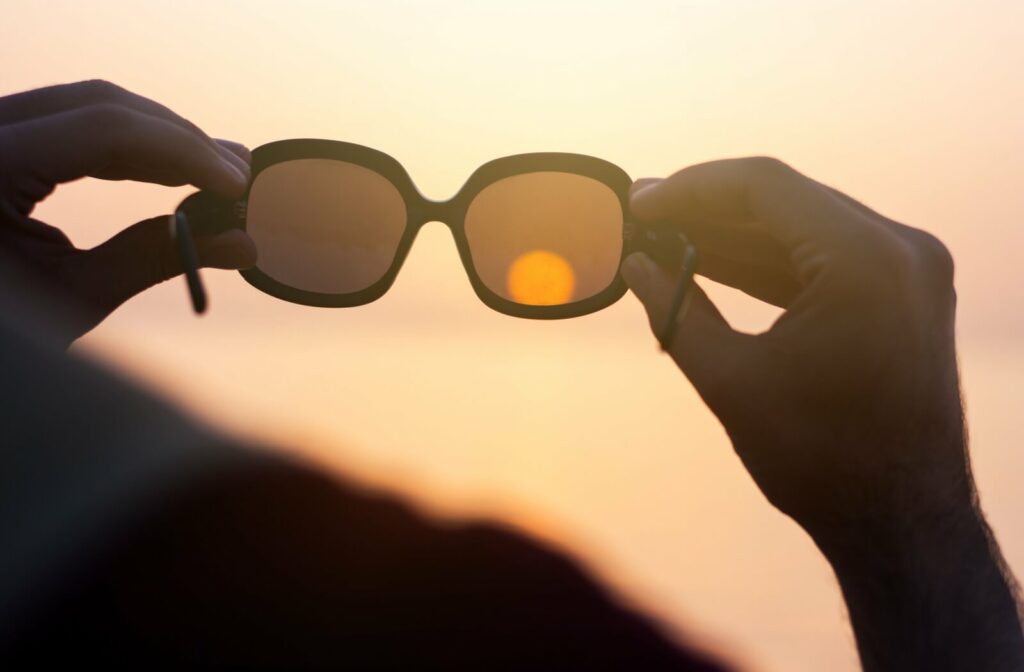Sunglasses do more than elevate your style. They’re an important part of protecting your eyes from sun damage. But here’s the catch: not every pair offers the same level of protection. While most sunglasses reduce brightness, polarized lenses go further by cutting glare and helping shield your eyes from harmful UV rays.
Polarized sunglasses reduce glare and provide added protection from UV rays, making them ideal for outdoor comfort and long-term eye health.
If you’re unsure whether your sunglasses are polarized, there’s an easy way to find out. Hold them up to an LED screen or reflective surface. If the glare fades or the screen appears darker as you rotate the lenses, they’re likely polarized.
At Niagara Vision in Niagara Falls, our team can guide you toward lenses that support both your comfort and your eye health.
How to Tell If Your Sunglasses Are Polarized
If your sunglasses aren’t clearly labelled, there are a couple of simple ways to test for polarization:
- Reflective surface test: Look at a reflective surface, such as a car hood or window, while wearing sunglasses. Rotate your sunglasses slowly. If the glare decreases significantly at certain angles, the lenses are polarized.
- LED screen test: View a phone or tablet screen through the lenses. If the screen darkens or appears black when the lenses are tilted, your sunglasses are polarized.
When Polarized Sunglasses Might Not Be Ideal
Though polarized sunglasses are great for most outdoor conditions, there are a few specific situations where they might not be the right choice:
- Driving on icy roads: Polarization can make it harder to notice slick or shiny patches.
- Winter sports: Activities like skiing and snowboarding often benefit from clear visibility of changing surface textures, which polarized lenses might obscure.
- Using digital screens: Polarized lenses can make it difficult to read LED or LCD displays.
- Low-light environments: Some people find that polarized lenses make it harder to see clearly in overcast or shaded settings.
In these cases, a non-polarized lens may actually improve your visibility and overall experience.
What to Know About Non-Polarized Lenses
Non-polarized sunglasses typically use tinted lenses to reduce brightness and improve comfort in sunny conditions. They often come with UV protection but don’t reduce glare, so light bouncing off water, pavement, or snow still reaches your eyes.
Because they’re more widely available and often more affordable, non-polarized lenses may appeal to casual users. However, they may contribute to squinting or eye fatigue during extended outdoor use, especially around reflective surfaces.
Why UV Protection Still Matters
Even when you’re not staring directly at the sun, your eyes are constantly exposed to UV rays. These rays come in 3 types:
- UV-A: The most common form of ultraviolet radiation, present even on cloudy days.
- UV-B: Stronger than UV-A, UV-B rays are partly absorbed by the atmosphere but can still cause harm.
- UV-C: The most dangerous form of UV radiation, but fortunately, it’s fully blocked by Earth’s ozone layer.
Both polarized and non-polarized sunglasses may provide UV protection, but only polarized lenses reduce glare in addition to blocking UV, offering more well-rounded visual comfort and support.
The Risks of UV Exposure to Your Eyes
UV rays may be invisible, but their effects can add up over time. Some of the eye conditions linked to UV exposure include:
- Cataracts: A clouding of the eye’s natural lens, often tied to age and long-term UV damage.
- Macular degeneration: A condition that affects the retina and can lead to central vision loss.
- Photokeratitis: A painful, sunburn-like condition affecting the cornea.
- Pterygium: A growth on the white part of the eye that may become irritated or obstruct vision.
Taking steps to reduce UV exposure, especially with appropriate sunglasses, can help lower your risk for these conditions.
Situations Where Polarized Lenses Make a Difference

For many people, polarized sunglasses offer a noticeable upgrade in visual comfort during specific tasks or conditions:
- Driving: Polarized lenses reduce glare from the road and other vehicles, improving clarity and comfort behind the wheel.
- Boating and fishing: Glare off water can be harsh and distracting—polarization helps reduce this glare so you can see below the surface.
- Outdoor activities: Whether you’re hiking, cycling, or relaxing outside, polarization can reduce eye strain and improve contrast in bright conditions.
Because they block horizontal light waves, polarized lenses help smooth out sharp reflections, offering clearer, more comfortable vision during bright days.
Choosing the Right Sunglasses for Your Needs
Not every pair of sunglasses will fit your lifestyle or visual needs and that’s okay. What matters is choosing eyewear that suits how and where you spend your time. Whether that means glare-reducing polarized lenses for outdoor recreation or non-polarized lenses for everyday tasks, the right fit depends on your unique activities and preferences.
Support Your Vision
From driving across town to spending a day near the water, polarized sunglasses can make your outdoor experience more comfortable and help protect your vision in the process. If you’re curious about polarized lenses or want to explore your options, we’re here to help.
Visit Niagara Vision in Niagara Falls to browse our selection of sunglasses or book an eye exam to learn more about protecting your vision from the sun.








